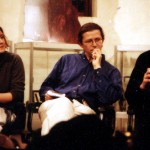
The Museum's Co-director Martin Humphries in Amsterdam during our collaboration with other European archives.
In the late 1990s Cinema Museum embarked on a collaborative restoration project with other European archives, funded by the Raphael programme of the European Commission, resulting in the creation of a DVD titled Exotic Europe, about travel in Europe shown in film from 1905-1926.
The DVD, accompanied by a booklet including detailed information about film restoration, can be purchased from the Cinema Museum Shop. A number of films from the Museum’s archive are featured in the collection, which contains remarkable footage revealing how the culture of cinema made it possible for broad sectors of the population to look at their place in the world with a new perspective. The travelling cameramen captured both everyday life and sensational occurrences, competing with one another in the search for spectacular images to show to the mass audience that filled the picture houses.
As a taste of the DVD collection, here is Cheddar, a short tinted film from 1920, produced by Ideal Films of Borehamwood near Elstree. While in its day this film would have appealed to a sense of nostalgia for a simpler, rural life felt by the growing number of city dwellers, it also shows the development of both the division and the mechanisation of labour in the process of cheese-making.
[tube]KXenEaVhrj4[/tube]
The films chosen for the project were 35mm cellulose nitrate films, most of which had suffered considerable shrinkage. In the silent era, colour film did not yet exist, but majority of the films, including those from the Cinema Museum, used early applied colour systems: tinting and toning gave a monochrome colourisation, while a more sophisticated technique of stencilling enabled the application of more colours in one frame. The Cinema Museum films were preserved using the Desmet method, named after Noel Desmet, the laboratory technician of the Royal Film Archive of Belgium who elaborated a technique for making colour prints from black-and-white negatives. Although the positive prints have to be printed on to colour stock, this technique allows a restoration with much closer approximation to the characteristics of the original.
In an extension of the project in 2010, supported by the European Commission in the UK, student filmmakers from the London Film School were invited to make short films in response to the archive footage, and these have been showcased at screenings at Europe House and at the Cinema Museum alongside the originals.


